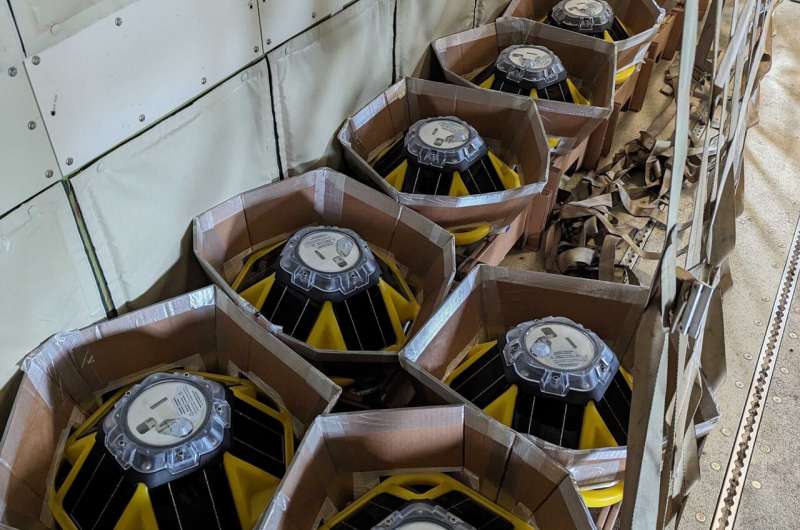This article has been reviewed according to Science X's editorial process and policies. Editors have highlighted the following attributes while ensuring the content's credibility:
fact-checked
trusted source
proofread
Research squadron VXS-1 mobilizes quickly to track Hurricane Idalia

U.S. Naval Research Laboratory's Scientific Development Squadron (VXS) 1 mobilized a crew for a NP-3C Orion operation with less than 24 hours' notice to airdrop 18 SOFAR Spotter buoys in the Gulf of Mexico ahead of Hurricane Idalia on Monday, August 28. The VXS-1 crew personally deployed the buoys from the aircraft on behalf of researchers working with the National Oceanographic Partnership Program (NOPP) Hurricane Coastal Impacts (NHCI).
VXS-1 airdropped the Spotters hours before Hurricane Idalia made landfall near Keaton Beach, Florida at approximately 7:45 a.m. EDT. The squadron deployed the fleet of Spotters into the path of the hurricane from 1,000 feet aboard the P-3 traveling at 150 mph. The buoys observed Hurricane Idalia's wave height, sea surface temperature, and barometric pressure in real-time between the afternoons of Monday, August 28 and Wednesday, August 30. The precisely executed drop enabled the Spotters to make direct observations near the eye wall and dangerous right-front quadrant of Idalia.
"The team pulled together quickly to execute the mission and aid the researchers with an opportunity they couldn't lose," said Project Director Lt. Cmdr. Nicholas Peter. "Hurricane Idalia intensified quickly and we're proud of the squadron's readiness and ability to meet our mission as the Navy's only research squadron."
The 10 Spotters continue to make real-time observations of wave conditions off the northwest coast of Florida. The data collected by the buoys will contribute to and improve existing forecast models and enable better understanding of hurricane dynamics, prediction of hurricane impacts, and be used to protect coastal communities. The NHCI project is focused on creating models for the U.S. Gulf Coast, Florida Coast and Eastern Seaboard.
"Our unique mission and ability to operate around the world, enabling research for the Department of the Navy and its partners is crucial to scientific and technological innovation," said Commanding Officer Cmdr. Aaron Roberts. "Airborne data-collection missions like the Idalia operation facilitate the next generation of scientific research and environmental prediction, keeping civilians and military members safe from extreme events."
The NHCI program consists of numerous government, industry, and academic partner organizations. These organizations are broken into five tasks and ten teams, with each team focusing on a specific task based on the team's expertise and the resources they have available. The U.S. Naval Research Laboratory (NRL)'s Marine Meteorology research team out of Monterey, California is assigned Task 0 while VXS-1 contributes operationally as demonstrated with the airdrop ahead of Hurricane Idalia.
The Marine Meteorology team uses NRL's proprietary Coupled Ocean-Atmosphere Mesoscale Prediction System for Tropical Cyclones (COAMPS-TC) and 11-member prediction ensemble system to accurately create hindcasts of hurricanes detailing the tropical cyclone track, size and intensity for retrospective analysis to contribute to atmospheric reforecasts and reanalyses. COAMPS-TC also provides real-time updates to other NHCI teams for timely prediction and operational readiness.
The NHCI aims to predict coastal impacts during hurricane seasons 2022-2024. These research-grade forecasts will facilitate innovation to better prepare coastal communities for extreme weather events. Since 1980, extreme weather events have cost the U.S. 1.8 trillion dollars and are expected to increase in intensity and frequency according to NOPP.
Provided by Naval Research Laboratory




















